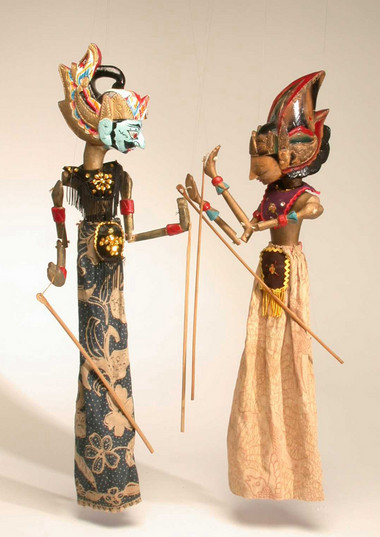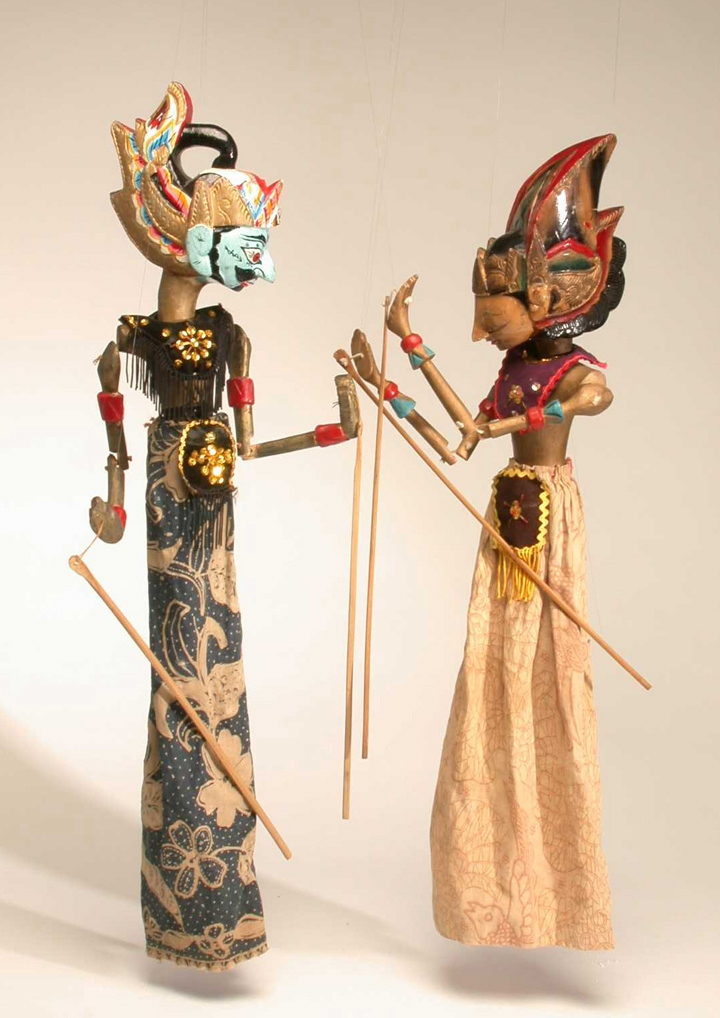Wayang Golek Rod Puppets, Java, Indonesia
In west Java, rod puppets are used in traditional puppet theatre (Wayang Golek). Performances take place in the open. They celebrate events such as births and weddings and can last all night, or are even presented over three nights. The dalang (puppeteer) is accompanied by a gamelan (percussion) orchestra and singers.
Each puppet has a carved and painted head with an elaborate headdress and a long neck that can swivel. The puppeteer can hold the rod that extends from the base of the trunk but more often it is inserted into a base to keep it still during performance. The puppeteer then has his hands free to manipulate the arms and can work two puppets at once.
Each puppet has a carved and painted head with an elaborate headdress and a long neck that can swivel. The puppeteer can hold the rod that extends from the base of the trunk but more often it is inserted into a base to keep it still during performance. The puppeteer then has his hands free to manipulate the arms and can work two puppets at once.
The puppets are carved from soft wood. They are decorated with remnants of cloth, as we see here. A bib with sequins and embroidery covers the torso and a long skirt hides the lower half of the trunk and the main rod. Sometimes the puppets are adorned with jewellery.
The word wayang refers to both the puppets and the theatre. Dating back the early 16th century, traditional Javanese tales and plays from the Ramayana and Mahabharata were performed. This variety of plays combines Hindu stories with Buddhist and Muslim ideas and Javanese folklore. Usually, the stories are divided into different episodes. They illustrate the fight of good against evil through conflict, culminating in the triumph of the good forces and the destruction of evil. The characters are always arranged on the stage in the same way – good characters halus to the right of the dalang, and bad characters kasars to the left.
Headdress, costumes and colours vary for each puppet and can also indicate to the audience what kind of character it represents. White means purity, virtue and moral integrity and is often the face colour of princes. Red means aggressiveness and anger and is usually the face colour of kasars. Blue and green face colours mean cowardliness and hypocrisy.
Wayang Golek can still be seen in Indonesia. Although some puppets are made for Wayang Golek theatre, many are now made for sale to tourists.In west Java, rod puppets are used in traditional puppet theatre (Wayang Golek). Performances take place in the open. They celebrate events such as births and weddings and can last all night, or are even presented over three nights. The dalang (puppeteer) is accompanied by a gamelan (percussion) orchestra and singers.



In west Java, rod puppets are used in traditional puppet theatre (Wayang Golek). Performances take place in the open. They celebrate events such as births and weddings and can last all night, or are even presented over three nights. The dalang (puppeteer) is accompanied by a gamelan (percussion) orchestra and singers.
Each puppet has a carved and painted head with an elaborate headdress and a long neck that can swivel. The puppeteer can hold the rod that extends from the base of the trunk but more often it is inserted into a base to keep it still during performance. The puppeteer then has his hands free to manipulate the arms and can work two puppets at once.
Each puppet has a carved and painted head with an elaborate headdress and a long neck that can swivel. The puppeteer can hold the rod that extends from the base of the trunk but more often it is inserted into a base to keep it still during performance. The puppeteer then has his hands free to manipulate the arms and can work two puppets at once.
The puppets are carved from soft wood. They are decorated with remnants of cloth, as we see here. A bib with sequins and embroidery covers the torso and a long skirt hides the lower half of the trunk and the main rod. Sometimes the puppets are adorned with jewellery.
The word wayang refers to both the puppets and the theatre. Dating back the early 16th century, traditional Javanese tales and plays from the Ramayana and Mahabharata were performed. This variety of plays combines Hindu stories with Buddhist and Muslim ideas and Javanese folklore. Usually, the stories are divided into different episodes. They illustrate the fight of good against evil through conflict, culminating in the triumph of the good forces and the destruction of evil. The characters are always arranged on the stage in the same way – good characters halus to the right of the dalang, and bad characters kasars to the left.
Headdress, costumes and colours vary for each puppet and can also indicate to the audience what kind of character it represents. White means purity, virtue and moral integrity and is often the face colour of princes. Red means aggressiveness and anger and is usually the face colour of kasars. Blue and green face colours mean cowardliness and hypocrisy.
Wayang Golek can still be seen in Indonesia. Although some puppets are made for Wayang Golek theatre, many are now made for sale to tourists.In west Java, rod puppets are used in traditional puppet theatre (Wayang Golek). Performances take place in the open. They celebrate events such as births and weddings and can last all night, or are even presented over three nights. The dalang (puppeteer) is accompanied by a gamelan (percussion) orchestra and singers.
- Term:
- Description:
- Halus
- The good puppet characters who are honest, brave and kind.
- Java
An island in Indonesia.
- Kasars
- The bad puppet characters who are dishonest, greedy and cruel.
- Wayang
Indonesian word meaning puppet.




















